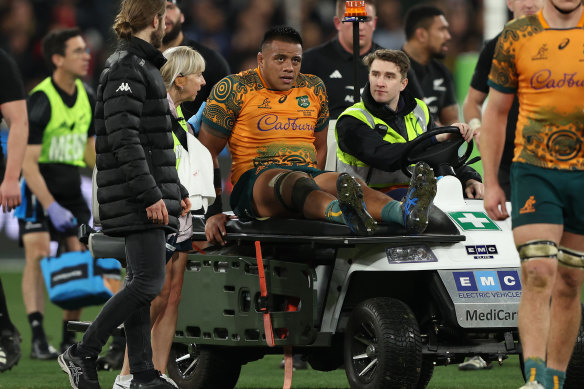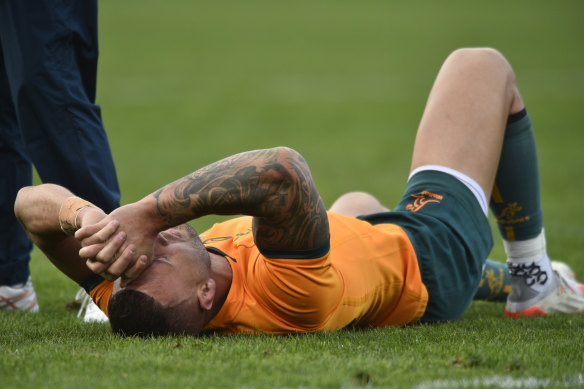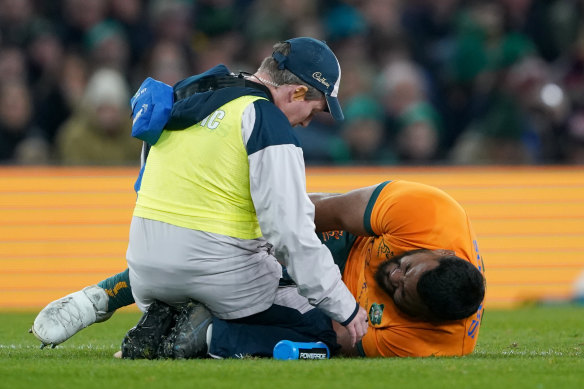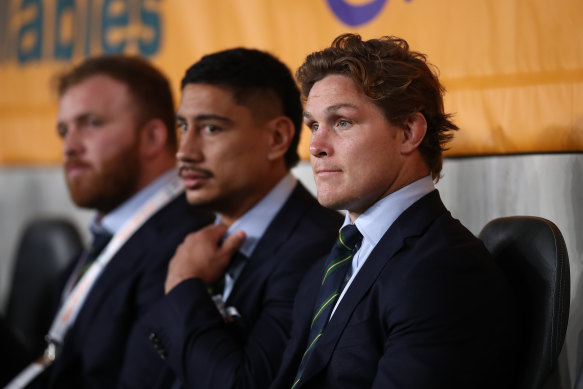An ‘alarming’ Achilles injury cluster in the Wallabies last year prompted a review. So why did another just occur?
By Iain Payten
Rugby Australia insist new injury-prevention systems arising from an “extensive” review into the Wallabies’ mass injury toll of 2022 are being used, despite star prop Allan Alaalatoa becoming the fifth player on Australian duty in 13 months to suffer a ruptured Achilles tendon.
Alaalatoa will miss the Rugby World Cup following surgery on the Achilles tendon in his left leg after suffering the catastrophic injury in the first half of the Wallabies’ loss to the All Blacks in Melbourne last weekend.
The tighthead prop, who is one of Australia’s highest-paid players, will be sidelined for around nine months. The factors that may have contributed to Alaalatoa’s injury have been questioned by some in Australian rugby, given the abnormal prevalence of the same injury for Wallabies players since last year.
Four Wallabies squad members suffered Achilles tendon ruptures last year: Harry Johnson-Holmes, Quade Cooper, Rob Leota and Taniela Tupou.
Compared to concussions, and joint and muscle injuries, major Achilles tendon injuries are rare, and former Rugby Australia chief executive Andy Marinos admitted last year the cluster was a big concern.
“Four Achilles tendons in one season is quite alarming, so absolutely there is going to be a review. It is a very high [injury] incident rate. Rest assured, it is a concern to all of us,” Marinos said in November.

Allan Alaalatoa is carted off the ground at the MCG last Saturday night.Credit: Getty
Ex-Wallabies coach Dave Rennie used a record 51 players across the season, and finished the Spring Tour with just 25 fit players.
A two-person review panel, led by the highly respected Dr Martin Raftery, looked into the injuries, training programs and the Wallabies’ systems, and the findings formed part of the wider high-performance review that was presented to the RA board in early January, just weeks before Rennie was removed and Eddie Jones was hired.
“The review covered: Case by Case Injury Incident Analysis, Training Program Review, Load Management Review, Staffing Structure and functionality in the relevant departments,” a RA spokesman said.
“It was important to take a holistic view of player management across the system as players transition in and out of the Super Rugby clubs and the Wallabies programs.

A distraught Quade Cooper lies on the turf in Mendoza.Credit: AP
“The review was extensive and contained numerous recommendations related to both the Rugby Australia (high-performance) system and the Wallabies. The bulk of these recommendations have been actioned and some are no longer relevant due to the substantial changes within Wallabies management.”
State bosses were given a “top-level” briefing by RA but did not receive a full copy of the Raftery findings, according to informed sources.
A source familiar with the review, who was not permitted to speak on the record, said the process looked at batches of injuries, to track how they occurred and whether patterns could be observed.
Among the recommendations made to the RA board was all injuries to Wallabies players should be investigated, no matter how small, to identify and fix potential systemic problems for the future.

Taniela Tupou injures his Achilles against Italy on last year’s Spring Tour.Credit: Getty
“The relevant recommendations have been actioned by the Wallabies,” an RA spokesman said. “The Wallabies have already done a deep dive into this (Alaalatoa) injury – as is standard process with any significant injury.”
Medical experts say previous lower leg injuries, age and heavy loading are all risk factors for an Achilles tendon injury, and there is at least one similar element in Alaalatoa’s case to the four who suffered Achilles tendon injuries last year.
Like Cooper and Tupou, Alaalatoa had recently returned from a calf injury, which kept him out of the Brumbies’ finals games in the Super Rugby post-season. Johnson-Holmes was also returning from an ankle injury when he did his during a long scrum training session, and Leota suffered his injury after cutting his ankle on a stationary bike the week before.
The Wallabies also did a heavy, three-day conditioning block on the Gold Coast before they flew to Melbourne last week, which loose forward Jed Holloway described as the toughest training of his career.

Michael Hooper has missed several Tests with a calf injury.Credit: Getty
The loss of Alaalatoa has further added to the caution being taken around Michael Hooper’s comeback from a lingering calf injury.
Asked about Alaalatoa becoming the latest to suffer an Achilles injury, prop Angus Bell said after the MCG loss that he felt injury was a risk of playing contact sport.
“It is a high-contact, high-physicality (game) and scrums you have almost two tonnes going through your legs as a front-rower, so it is a hard position and a hard game,” Bell said.
“Those things happen. It is a freak accident, stuff like that. It is something you can’t prepare for.”
Watch all the action from The Rugby Championship with every match streaming ad-free, live and on demand on Stan Sport.
Sports news, results and expert commentary. Sign up for our Sport